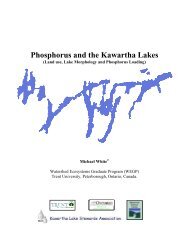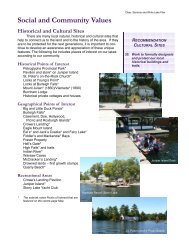Lake Water Quality 2006 Report - Lakefield Herald
Lake Water Quality 2006 Report - Lakefield Herald
Lake Water Quality 2006 Report - Lakefield Herald
Create successful ePaper yourself
Turn your PDF publications into a flip-book with our unique Google optimized e-Paper software.
The Mississagua River Diversion of the 1800’s: <strong>Water</strong> qualityimplications today for the Bald, Pigeon and Buckhorn <strong>Lake</strong>sby Kevin WaltersI have been investigating some interesting physiographical anomalies in the Buckhornarea that led me to the conclusion that the Mississagua River, which currently entersthe main Kawartha <strong>Lake</strong> system just downstream of Buckhorn into Lower Buckhorn<strong>Lake</strong>, once split into two paths. One headed to Lower Buckhorn as it does today, whilethe other branched west to Big Bald <strong>Lake</strong>.There is sufficient physical evidence proving that the river once utilized a channelleading into Big Bald <strong>Lake</strong>. Its most discernable legacy is the marshy delta locatedjust north of the village of Buckhorn, visible just west of County Rd 36, and theconnecting broad channel leading into Big Bald <strong>Lake</strong>, known as Catalina Bay.But was this route to the Bald <strong>Lake</strong>s or its diversion into one channel natural or manmade?The key to determining that humans had in fact caused the diversion would befinding a dam or other man-made structure located within an otherwise naturalbranch of the river that would have resulted in the current singular course.I did indeed find such a structure in the location I predicted: a barrier or “blind” damof earth and stone crossing the top end of what was clearly a natural, westernchannel, located about 1 km north of the old Scotts Mills dam. (See map pg. 56)Further investigations suggest that both east and west channels of the MississaguaRiver were likely approximately equal in terms of volume of discharge originally, andthe river may have naturally switched from one channel to the other from time totime, as we know that, historically, blockages of deadwood abounded on our arearivers.While this still needs to be fully researched, my hypothesis is that lumbermenconstructed this barrier around the time of the founding of Hall’s sawmill atBuckhorn, circa 1830. Presumably they wanted to send all the logs heading down theMississagua River to the mills at Buckhorn without losing any to the Bald <strong>Lake</strong>s.Scotts Mills, located on the river above Buckhorn, but founded 24 years later, likelytook advantage of this arrangement too. Without the diversion dam, their mill-damwould have backed up the water and sent it all down the west channel to Big Bald54





